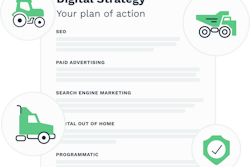
Windrose Technology and its founder, chairman, and CEO, Wen Han, were among the biggest attractions at the 2025 ACT Expo in Anaheim, Calif.
The recently EPA-approved Windrose R700 Class 8 battery-electric semi, currently running routes for Arizona-based JoyRide Logisitics, is shaping up to be one of the most serious rivals to the also upcoming Tesla Semi, due to begin volume production next year in Nevada.
But the big question is when will these two rigs face off on the open road?
[Related: China's Windrose could be Tesla Semi's biggest rival]
Production start date
Speaking to Clean Trucking at the event, Wen Han confirmed that R700 series production is due to get underway in Q3 of this year at an unexpected location.
"We will be starting US assembly this year," Han stated. "Let's call it Q3 of this year."
A separate source suggested July is the target.
Production, meanwhile, is slated to happen in Huntington Beach, Calif. Previously, Savannah, Ga. was the rumored production site.
As a global manufacturer, Windrose has a production site in Antwerp, Belgium for EU-bound semis. Final assembly for the Asian and Oceania markets takes place in those regions.
Mr. Han added that the company is "looking to build a bigger site in France and then a bigger site in the U.S. We're down to a small number of sections or a small number of states, [including] Canada. Now it's just a matter of which one we find to be the best match."
No timeframe was offered.
Major components, including the chassis, e-axles, batteries, and suspension are expected to be produced in China.
[Related: Check out the Windrose inside and out; the Tesla Semi's best competitor?]
Different production approach
Han continued to say that his company's approach to production differs from that of Tesla.
"That's not to say this is a Tesla style factory. We have a lot of great respect for Tesla, which I publicly mentioned. Tesla has done many fantastic things. They do have a giant facility for the Semi trucks, but what we're doing is much less than that [with] modular, smaller in scale, but much more nimble [production methods]. That's how we start. It is a fairly different approach."
One critical vehicle component Mr. Han did mention is tires and the challenges of designing them for heavy battery-electric Class 8 rigs like the 98,000-pound GVWR Windrose.
"EV truck tires wear out much more quickly. That's just a fact," Han continued. "So we're working with a number of the tire suppliers to design a sort of a bespoke EV tire that's good for electric vehicles. We're trying to globalize it. It may not be easy to do, but we're trying to find a single solution that's good for the world. Even for something as simple as a fifth wheel because the Australian [market] fifth wheel is different from the American fifth wheel, which is different from the European fifth wheel. So we're trying to actually fix that."
U.S. battery production downside
Despite President Trump's ongoing trade war, Han doesn't think it absolutely necessary to manufacture batteries domestically. Instead, he feels the U.S. should shift focus to producing as much energy as possible and, at least in Windrose's case, import the batteries.
"Battery supplies are quite limited in the U.S., so why make the thing that's hard to make instead of making the thing that's easy to make, which is the electrons," he said. "I think it's actually better for the United States to generate electricity and just put up chargers everywhere. Modern American society is based on chargers, not on batteries sitting everywhere because it's so much easier for the socket to be harmonized than for the batteries to be harmonized."
The country's vast energy production potential cannot be ignored, he stresses.
"North America is blessed with huge amounts of resources. Hydraulic, natural gas, coal, wind, and solar."
Overseas markets
Compared to China and parts of Europe, the U.S. market has been slow to adapt to battery-electric long-haul rigs, mainly due to a lack of charging infrastructure and high price tags.
Han, however, views this as an opportunity for international cooperation.
"China doesn't have to be beating the U.S. in electrification. Everybody should just try to do it for their own sake," he explained. "So I think many people are getting over that now, which is realizing it's okay to learn from other countries. For example, China didn't invent the lithium-based battery. The lithium-ion battery was actually a U.S. invention popularized by the Japanese in cameras, camcorders, etc."
Last market globally
Like the Tesla Semi, the Windrose R700 is a global vehicle. But unlike the Semi, the Windrose is already on the road overseas. Last July, an R700 completed a 2,800-mile road trip test from New York to Los Angeles.
[Related: Windrose delivers first batch of EV semis]
"We're coming to the U.S. almost as sort of our last market globally. We've done so much more in Europe, China, Australia, and New Zealand," Han said. "But the U.S. continues to be the biggest market for all intents and purposes."
The Windrose R700 is equipped with a 729 kWh battery, an 800V high-voltage platform capable of megawatt-level dual-inlet charging, a drag coefficient of 0.2755, and a loaded autonomous range of 670 km (416 miles).
Final pricing has not been announced though a starting figure of around $250,000 is rumored.
Windrose has the backing of several major Chinese manufacturers, including the Anhui Jianghuai Automotive Group (JAC).










